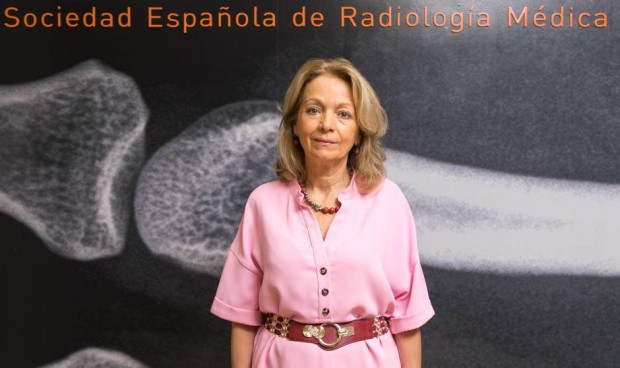Separation of Covid circles remains in the radiology department

Milagros Martí de Gracia, President of the Spanish Society of Medical Radiology (SERAM).
In this sense, it refers to medical writing that ‘interruption COVID-19 He showed that radiology is a central, transversal and dynamic discipline, capable of adapting to the problems that a situation like the one we have experienced can generate. In addition, he advocates certain developments such as the separation between ‘clean’ and ‘dirty circles’ should remain in National Health System (SNS)The ideal is that whenever possible there is an independent and differentiated circuit for SARS-CoV-2 infected patients or suspected of it.
Now that the Covid-19 epidemic has begun to subside, what role is the radiology department playing in this ‘de-escalation’?
Initially, the demand for chest radiographic examinations diminished in terms of the need to perform them urgently. Activity related to Covid-19 is now more focused on monitoring patients with persistent symptoms or complications.
On the other hand, for several months there were centers where patients infected with SARS-CoV-2 became, almost exclusively, the main radioactivity. We have dedicated most of our resources to your attention. This dedication has had a negative impact on other diseases, especially those that do not appear acutely or urgently, cancer patients or those with chronic diseases, preventive screening programs …
Radiology services are already working with all available technical and human resources, but we are still seeing the negative impact of the pandemic on non-Covid-19 patients due to serious delays in diagnosis or disease control.
What will your role be in the near future?
Radiology is the diagnostic support for more than 90 percent of operations. There is practically no disease that does not require a radiological examination for diagnosis, monitoring, assessment of response to treatment, detection of complications or, simply, the exclusion of other processes.
|
Radiology is the diagnostic support for more than 90% of operations. |
Moreover, with the development of new technologies, more and more accurate diagnoses can be made, which makes radiology even more important.
And in the Long Covid approach?
Computerized tomography (CT) in particular is one of the main examinations in the follow-up of patients with Covid-19 who present with persistent symptoms, as it allows us to assess the degree of accuracy of inflammatory changes or eventual progression to fibrosis, which would be one of the most common complications which they fear.
In most centers, multidisciplinary teams have been organized to care for these patients, and, of course, the radiologist plays a crucial role.
What lessons learned or approved changes during the pandemic will remain in radiological diagnostic services?
The organization in radiology services adapts to the needs of the pandemic at all times, allocating more rooms, equipment or radiologists according to the demand for care. But something has come to stay: the separation of “clean” and “dirty” circuits, spatially or temporally, depending on the capacity of each service, which is very effective.
|
The radiologist must be involved in all stages of the healthcare process. |
Ideally, whenever possible, an independent and differentiated circuit should be maintained for patients infected with or suspected of having SARS-CoV-2.
Can a greater appreciation for the specialty be expected after its hard work in the pandemic?
Radiology has clearly played an essential role in the treatment of SARS-CoV-2 patients, particularly in assessing the prevalence of lung disease, as a prognostic marker, but also in identifying complications (both in those related to disease. Thrombotic effects of disease such as bacterial infections are highly additive or those secondary to barotrauma due to positive pressure of mechanical ventilation).
Radiology is the diagnostic and control support for most pathological processes, both acute and chronic, and it was no different in Covid-19.
|
Radiology is a central, transversal and dynamic specialty. |
The emergence of Covid-19 has demonstrated that radiology is a central, transversal and dynamic discipline, capable of adapting to the problems that a situation like the one we have experienced, and has appreciated the important contribution of all technicians and radiologists to the diagnostic and therapeutic management of patients infected with SARS-CoV-2. . Radiologists have taken on the tasks of examining, diagnosing, stratifying, treating and following up on all cases of Covid-19 (mild, medium and severe), and helping the rest of the doctors make decisions about the care they need for patients.
Therefore, given the distinguished central position and cross-sectional view that radiology has on disease, we believe from SERAM that there should be greater recognition of the work of professionals and demonstrate the importance of including a radiologist throughout the patient care process and strengthening the staff of radiologists in the national health system.
Although it may contain statements, statements or notes from health institutions or professionals, the information in medical writing is edited and prepared by journalists. We recommend that the reader be consulted on any health-related question with a healthcare professional.

“Award-winning zombie scholar. Music practitioner. Food expert. Troublemaker.”


/cloudfront-eu-central-1.images.arcpublishing.com/prisa/AHVYMMDSTZDTDBFNZ3LMFUOKNE.jpg)








